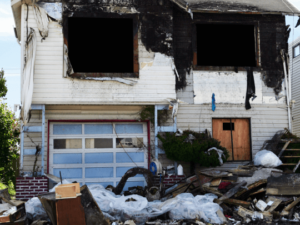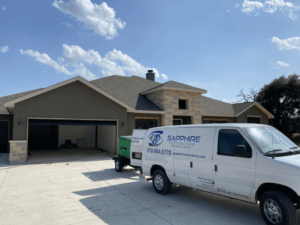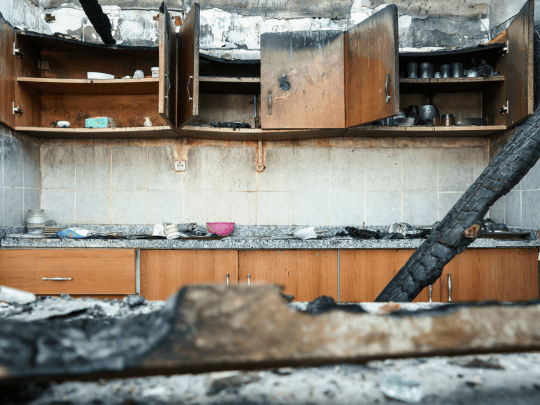If you’ve ever experienced a fire in your home, you already know that dealing with the aftermath can feel overwhelming. The sight of blackened walls, the lingering smell of smoke in the air, and the overall sense of chaos can make anyone feel lost. But don’t worry—you’re not alone. Here at Sapphire Restoration, we’ve seen it all, and we’re here to help guide you through the process of cleaning smoke damage and restoring your home to its former glory. Let’s dive into how to tackle this head-on with confidence!
What You Need to Know About Smoke Damage
 Smoke doesn’t just disappear into thin air once the fire is out. It leaves behind traces of itself in various forms, and unfortunately, not all smoke damage is the same. Let’s break it down.
Smoke doesn’t just disappear into thin air once the fire is out. It leaves behind traces of itself in various forms, and unfortunately, not all smoke damage is the same. Let’s break it down.
- Wet Smoke: This comes from smoldering fires that burn at a low temperature. Think of a smoky, slow-burning fire with lots of moisture in the air. Wet smoke tends to be sticky and thick, making it a challenge to clean.
- Dry Smoke: This type occurs during fast-burning, high-temperature fires. Dry smoke is powdery and fine, which makes it easier to clean in some cases. However, don’t be fooled—it can still leave a stubborn residue.
- Protein Residue: You might not think about protein when it comes to fires, but fires that involve burning food can leave behind a nearly invisible residue. You’ll know it’s there by the lingering smell, though. And let me tell you, it’s not pleasant.
- Fuel/Oil Residue: Thankfully, this is more common in industrial settings, but it can happen at home if your fire involves an oil furnace. The residue left behind is sticky and dense, making it one of the most difficult types of smoke damage to clean.
Understanding the type of smoke damage you’re dealing with is key to choosing the right cleaning approach. For instance, what works for dry smoke may not be effective for sticky wet smoke. And protein residue? Well, that’s a whole different beast!
Read more: For more in-depth guidance on what to look for after a fire, check out our Complete Guide to Assessing Fire Damage: What You Need to Check.
How Smoke Affects Different Surfaces
Smoke damage doesn’t just settle on the walls and call it a day—it finds its way into every nook and cranny, affecting a variety of surfaces in your home. Let’s break down how different materials react to smoke:
- Walls and Ceilings: These are usually the hardest hit. Smoke rises, which means your ceilings might bear the brunt of the damage. Depending on the type of paint or wallpaper, cleaning can be tricky.
- Furniture and Fabrics: Smoke doesn’t discriminate. Upholstered furniture, carpets, and curtains will absorb smoke and its odor quickly. The longer you wait to clean these items, the harder it becomes to get rid of that smoky smell.
- Wood and Metal: Smoke can cause wood to discolor and metal to corrode over time. That’s why it’s important to clean these surfaces as soon as possible to avoid long-term damage.
Essential Tools and Materials for Cleaning Smoke Damage
So, now that you’ve got a better understanding of the smoke types and their sneaky ways, it’s time to gather your cleaning arsenal. Here’s what you’ll need to tackle smoke damage effectively:
- Dry Sponges: Also known as chemical sponges, these are essential for wiping down walls and other surfaces without smearing the smoke residue.
- Trisodium Phosphate (TSP): This heavy-duty cleaner is fantastic for scrubbing stubborn smoke stains off walls and surfaces.
- White Vinegar: A natural deodorizer, vinegar can help neutralize lingering smoke smells, especially in fabrics.
- Baking Soda: Another great deodorizer, baking soda, can be sprinkled onto carpets and upholstery to absorb odors.
- Vacuum with HEPA Filter: A vacuum equipped with a HEPA filter will help remove soot and fine particles without blowing them back into the air.
- Rubber Gloves and Masks: Smoke damage often involves harmful particles, so make sure you’re protecting yourself while cleaning.
- Air Scrubber or Ozone Generator: These machines are handy for removing lingering odors and improving air quality after smoke exposure.
Tips for Choosing the Right Products
Choosing the right product depends on the type of surface and the type of smoke damage you’re dealing with. For example, you wouldn’t use a chemical sponge on fabric, and TSP can be too harsh for delicate surfaces like wood. Always test a small area before committing to a cleaning method.
Step-by-Step Smoke Damage Cleaning Techniques
Now that we’ve covered the groundwork, let’s get into the meat and potatoes to restore the smoke damage. Below is a step-by-step guide to cleaning smoke-damaged walls, ceilings, furniture, and fabrics.
- Ventilate the Area: Open all windows and doors to get some fresh air flowing. This not only helps clear out some of the lingering smoke smell but also provides a healthier work environment.
- Dry Sponge First: Before introducing any liquids, use a dry chemical sponge to wipe down all surfaces. This helps lift the soot without spreading it around. Think of it like using a lint roller before you wash your clothes—it makes a big difference!
- Tackle Walls and Ceilings with TSP: Mix TSP according to the package instructions and use a sponge to scrub the walls and ceilings. Don’t be too aggressive, or you might damage the surface.
- Deodorize Carpets and Fabrics: Sprinkle baking soda on your carpets and upholstered furniture, let it sit for a few hours, then vacuum it up. This helps absorb some of the lingering odors. For a deeper clean, steam cleaning might be necessary.
- Neutralize Odors with Vinegar: Place bowls of white vinegar around the room or use it as a cleaning solution for hard surfaces. It works wonders for eliminating smoke smells without leaving behind a harsh chemical odor.
- Clean Metal and Wood Surfaces: Use a gentle cleaner for these materials and avoid abrasive scrubbing. Smoke can make wood look dull and metal tarnish, so treat these surfaces with care.
- Use Air Scrubbers or Ozone Generators: If the smoke smell persists, it’s time to bring in the big guns. These machines can help remove airborne particles and lingering odors.
When to Call in the Professionals
 While we’re all for a good DIY project, some smoke damage might be more than you can handle on your own. If the smoke has penetrated your HVAC system and walls, or if the damage is extensive, it’s time to call in the pros. If you need professional restoration services, check out the service areas we cover.
While we’re all for a good DIY project, some smoke damage might be more than you can handle on your own. If the smoke has penetrated your HVAC system and walls, or if the damage is extensive, it’s time to call in the pros. If you need professional restoration services, check out the service areas we cover.
At Sapphire Restoration, we know how tricky smoke damage can be. Our team is fully certified and experienced in restoring homes after a fire. We’ve seen every type of smoke damage imaginable, and we have the tools, expertise, and dedication to get your home back to normal. If you’re in the San Antonio area, give us a call. We’ll handle the tough stuff so you can breathe easy (literally).
Preventing Future Smoke Damage
Of course, the best way to deal with smoke damage is to prevent it from happening in the first place. Here are a few tips to keep your home and family safe:
- Install Smoke Alarms: This seems like a no-brainer, but you’d be surprised how many homes lack working smoke detectors. Make sure you have one in every room, and test them regularly.
- Create a Fire Escape Plan: Know your exits and have a fire escape plan in place for your family.
- Maintain Appliances: Regularly check and clean your stove, fireplace, and other appliances to prevent fires from starting.
Read more: Cooking-related fires are a major risk, especially during the holidays. For helpful tips on staying safe, take a look at our Fire Safety in the Kitchen During the Holidays.
Bringing Your Home Back to Life: Ready to Restore after Smoke Damage?
Dealing with smoke damage can feel overwhelming, but you don’t have to face it alone. Whether it’s tackling the cleaning yourself or bringing in the professionals, the most important thing is to take action quickly to protect your home and health. At Sapphire Restoration, we’re here to help you every step of the way. With over 15 years of experience, our team has the expertise and dedication to get your home back to its best condition—fast and hassle-free.
Ready to take the next step? If you’ve experienced smoke damage or need expert fire restoration services, don’t wait. Contact us today for a free inspection, and let us help you restore your home to its pre-loss condition. We serve the greater San Antonio area and are just one call away from giving you peace of mind.
Resources:
National Fire Protection Association (NFPA) – Fire Safety Tips

